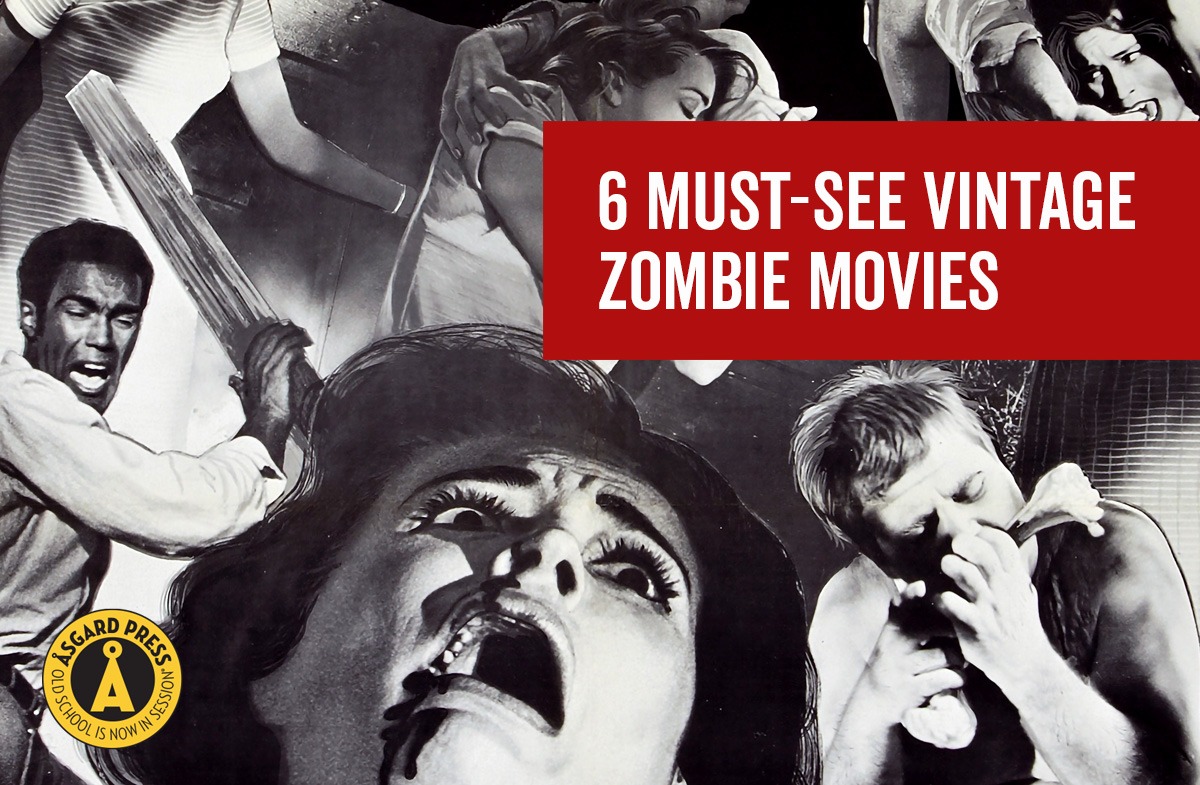6 Must-See Vintage Zombie Movies
Spooky season is upon us and there’s no shortage of spine-tingling movies to stream, including films featuring everyone’s favorite undead characters, zombies. Join us as we explore six must-see zombie movies that have left an indelible mark on popular culture. From the eerie atmospheres to the relentless hordes of the reanimated, these films have helped define the zombie genre. In this article, esteemed pop culture historian, Dr. Arnold T. Blumberg, lends his expert insights and commentary, providing a deeper understanding of the cultural impact and significance of each cinematic offering. Prepare for a spine-tingling adventure into the realm of the walking dead.
Dawn of the Dead (1978)
Studio: United Film Distribution Company; Director: George A. Romero; Cast: David Emge, Ken Foree, Scott Reiniger, Gaylen Ross.
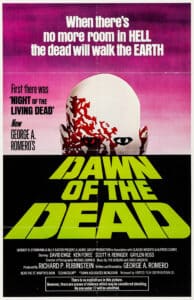
Although Romero’s Night of the Living Dead virtually invented the concept of the modern zombie, it is with Dawn that so many of the genre’s most familiar tropes and storytelling ‘rules’ were introduced and set down for generations of horror film makers to come. As our usual unlikely group of survivors – two TV station employees and a couple of SWAT police officers – make their way to safety in the midst of a zombie apocalypse, they decide to set up temporary house at the then-new phenomenon of the day, an indoor shopping mall. Perfectly reflecting the tailor-made metaphor of rampant consumerism in both the setting and the ravenous undead stalking its halls, Dawn of the Dead is a template for social and cultural commentary through the use of zombies. Featuring a stunningly bleak and yet occasionally peppy score by Goblin and overcoming the unfortunate makeup miscalculation that left the living dead in this film with an overtly blue-tinged pallor, the movie exists in multiple cuts released in the US, internationally, and via home video. In any form, Dawn is a powerful indictment of the worst aspects of human nature that manages to presage its successors, such as The Walking Dead, while also serving as a terrifying time capsule of late ’70s America.
Zombie (1979)
Studio: The Jerry Gross Organization; Director: Lucio Fulci; Cast: Tisa Farrow, Ian McCulloch, Richard Johnson, Al Cliver, Auretta Gay, Olga Karlatos.
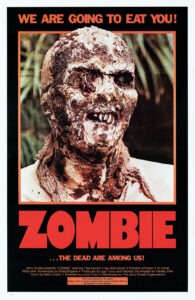
Capitalizing on the success of Dawn of the Dead when it was released in Italy under the title Zombi, this unofficial sequel – called Zombi 2, Zombie in the US, and Zombie Flesh Eaters in the UK – takes the daughter of a research scientist (Farrow) and an investigative reporter (McCulloch) to the island of Matool, where they meet another couple (Cliver, Gay) and discover Dr. Menard (Johnson) dealing with a plague of the living dead. An iconic film whose poster image symbolized the genre for generations with its unforgettable close-up of a skull-like, decaying corpse with worms in one eye (eventually appearing on countless black t-shirts in horror fandom for decades), Zombie also included some infamous sequences, such as a battle between a zombie and a shark at the bottom of the ocean depths (performed by a real shark and a shark trainer in makeup), and a concluding scene shot illegally on top of the Brooklyn Bridge. Fabio Frizzi’s score – in particular his propulsive, pounding theme – remains a highlight among zombie movies, and fans still regularly intone Johnson’s cold delivery of the movie’s most quotable line (which is heard twice at different points in the film). In the early 1980s, Zombie was one of the original 39 “video nasties” successfully prosecuted in the UK by their DPP (Director of Public Prosecutions) for obscenity.
Toxic Zombies (1980)
Studio: CM Productions; Director: Charles McCrann; Cast: Charles Austin (McCrann), Beverly Shapiro, Dennis Helfend, John Amplas.
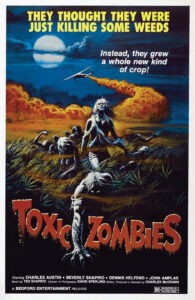
Also known as Forest of Fear, Bloodeaters, and The Dromax Derangement, Toxic Zombies is a truly low-budget (more like no-budget) effort in which a group of marijuana farmers that just want to grow their crops in peace and be super mellow about it all are targeted by a government-approved herbicide called Dromax as part of an anti-drug initiative. When the substance washes over their crop of cannabis, and winds up turning the farmers into vicious cannibal monsters as well, a wave of bloody flesh-eating is bound to erupt. Frequent George Romero regular John Amplas (Dawn of the Dead, Day of the Dead, Martin, Creepshow) makes an appearance as a federal agent to lend the proceedings just a bit of genre credibility. The movie is credited by some as being the first in the subgenre of “redneck” zombie movies, which are surprisingly numerous, especially throughout the 1980s. Early in that decade, Toxic Zombies was also one of the original 39 “video nasties” successfully prosecuted in the UK by their DPP (Director of Public Prosecutions) for obscenity. And in perhaps the most sobering detail presented in this calendar, helmer Charles McCrann went on to become the Senior Vice-President of Marsh & McLennan, a financial services company that had offices in the World Trade Center in New York City; McCrann died there on September 11, 2001.
War of the Zombies (1965)
Studio: American International; Director: Giuseppe Vari; Cast: John Drew Barrymore, Susi Andersen, Ettore Manni, Ida Galli.
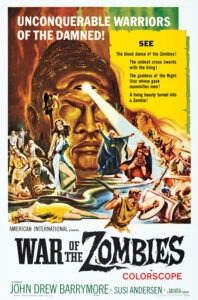
Barrymore – yes, father of Drew, and part of Hollywood royalty – stars in an Italian peplum (sword-and-sandal) epic also known as Rome Against Rome (when aired on television, it was retitled Night Star: Goddess of Electra). A Roman centurion (Manni) clashes with a maniacal cult leader and sorcerer named Aderbad (Barrymore) who is, of course, building a zombie army. Discovering that a powerful artifact may hold the key to untold riches and the defeat of the evil forces, the centurion goes on a heroic quest that also helped to usher in the end of the hugely popular peplum cycle in Italy, giving way to the growing popularity of the “Spaghetti Westerns.” Although this is peripherally considered a zombie movie – after all, they’re mentioned in the title (which is not a foolproof way to tell) – the undead creatures seen here are more like ghosts than zombies. The film’s ending used stock footage lifted from the 1959 Victor Mature vehicle, Hannibal. This was one of Barrymore’s last film roles toward the end of a very uneven career marked by controversy and unpredictable behavior; he segued into several television appearances throughout the 1960s and early ’70s – mainly westerns – before becoming a virtual recluse; he died in 2004 at age 72.
Rabid (1977)
Studio: New World Pictures; Director: David Cronenberg; Cast: Marilyn Chambers, Frank Moore, Joe Silver, Howard Ryshpan.
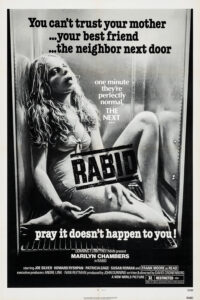
Adult film star Marilyn Chambers is Rose, a woman that develops a vampiric desire to feast on human blood when experimental surgery after a motorcycle accident goes awry. When her attacks initiate an infectious plague that spreads and transforms victims into ravenous zombies, society teeters on the brink of collapse. One of Cronenberg’s early films that helped to establish him as a new force in modern horror, utilizing his often-disturbing and even disgusting “body horror” approach to the genre, Rabid was originally intended to star Sissy Spacek, who went on to play the lead role in the Stephen King adaptation, Carrie (a poster for which appears in this film, as that movie was released to huge success before Rabid completed production). Chambers, whose adult industry career had generated controversy since she also appeared as the mother on boxes of Ivory Soap (“99 44/100% pure”), was cast by executive producer Ivan Reitman, who believed that her presence would increase the chances of successfully marketing the film worldwide. Preceding George Romero’s Dawn of the Dead by just one year, Rabid is one of several films that explores the phenomenon of a zombie-like outbreak and its effect on the urban landscape of the late 1970s, with predictably disastrous results. A 2019 remake helmed by sisters Jen and Sylvia Soska failed to capture the raw power of the original.
Night of the Living Dead (1968)
Studio: Image Ten; Director: George A. Romero; Cast: Duane Jones, Judith O’Dea, Marilyn Eastman, Karl Hardman, Judith Ridley, Keith Wayne, Kyra Schon, Bill Hinzman.
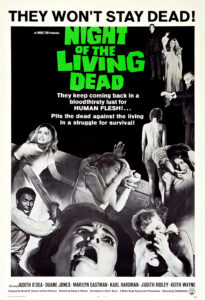
Entire books have been written about this landmark horror film, and over fifty years later, its impact has not diminished. The harrowing tale of an unlikely group of survivors trapped in a Pennsylvania farmhouse as the unburied dead gather outside, hungry for living human flesh, Night tackles everything from race and gender politics to the disintegration of the post-war American nuclear family and the Vietnam-era desensitization to violence. Although the production was accomplished with a low budget and chocolate syrup subbing for blood, there is no denying the power behind some of its most memorable macabre sequences, including a climactic confrontation between a mother and her own undead daughter. While much of the movie’s legacy is associated with its shocking subject matter and barrier-shattering visuals, like a scene in which the reanimated dead feast on two of the survivors, the real dramatic center-point of the film is what fans refer to as the “Beekman’s Diner speech.” In the midst of creepy carnage from carnivorous corpses and constant arguing amongst the survivors, Ben (Jones) takes center stage for several quiet minutes as he tells the story of his experience at the diner just prior to arriving at the farmhouse. It’s an unforgettable, nuanced, and painfully real performance. This icon among zombie movies is now in the public domain and you can watch it in its entirety here.
From the haunting origins to the apocalyptic landscapes, zombie movies remain a fascinating lens through which we examine our fears, our resilience, and our collective fascination with the macabre. If you’d like to read even more about why humans enjoy horror stories, check out our blog post, A Brief History of Horror Comics. Special thanks to Dr. Arnold T. Blumberg, who’s zombie expertise has shed light on the lasting impact and cultural relevance of these films, emphasizing how they continue to resonate with audiences, sparking discussions beyond the realm of the undead. So, dim the lights, gather your courage, and immerse yourself in these iconic cinematic experiences.
Want to see more fearful and fascinating movie creatures? Our 2024 Vintage Monsters Calendar features 13 monster movie posters and our 2024 Vintage Spirits, Demons & Warriors Calendar showcases traditional Japanese woodblock art with a variety of otherworldly beings. Display your favorite monsters year round!

